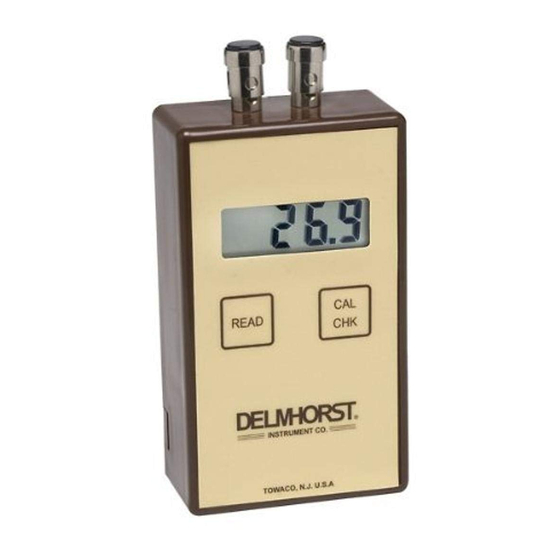
Table of Contents
Advertisement
Quick Links
TABLE OF CONTENTS
1 Introduction
3
Figure 1
4
Figure 1A
5
5
7
Figure 3
8
8
9
INTRODUCTION
The Delmhorst soil moisture measuring system consists of two parts: the gypsum
soil blocks (sensors) and the measuring instrument, Model KS-D1 moisture
tester. The blocks are made of gypsum cast around two concentric electrodes.
The gypsum acts as a buffer against the effect that the salts might have on the
electrical conductivity and the concentric electrodes confine the flow of current to
the interior of the block, eliminating the effects of soil conductivity.
When a block is buried in the soil it absorbs moisture from the soil or releases
moisture into the soil, until its moisture content approaches equilibrium with the
moisture content of the soil. When the block is connected to the meter, current
flows between the electrodes and the electrical resistance of the gypsum is
measured. Such readings are an indication of the moisture available to the
plants.
For irrigation purposes, the water of importance is that amount which can be
extracted from the soil by the roots of the plants, and not the percent moisture
content (which is related to the weight of the soil). We refer to this reservoir of
moisture as "available moisture."
Each soil has a different capacity to hold water, depending on its structure and
texture. The maximum amount of water available to the plants (called Field
Capacity) is the amount held by the soil against drainage by gravity. When
Delmhorst Instrument Co.
Model KS-D1
Operating Instructions
1 of 12
Advertisement
Table of Contents

Subscribe to Our Youtube Channel
Summary of Contents for Delmhorst Instrument Co KS-D1
-
Page 1: Table Of Contents
INTRODUCTION The Delmhorst soil moisture measuring system consists of two parts: the gypsum soil blocks (sensors) and the measuring instrument, Model KS-D1 moisture tester. The blocks are made of gypsum cast around two concentric electrodes. The gypsum acts as a buffer against the effect that the salts might have on the electrical conductivity and the concentric electrodes confine the flow of current to the interior of the block, eliminating the effects of soil conductivity. - Page 2 virtually all available water has been used (that is when no further moisture can be extracted by the plant) soil moisture has reached the level known as the "Permanent Wilting Point.” With soil moisture at this level, plants permanently wilt and die. Finely textured soils such as fine sandy loams and clay loams hold a greater amount of water at field capacity then coarsely textured soils such as coarse sandy loams.
- Page 3 3 of 12...
- Page 4 4 of 12...
-
Page 5: Figure
OPERATING PROCEDURE FOR KS-D1 1. To check the meter calibration: Press the “CAL CHK” button. The meter should read 80.0 ± 1.0. Note: Instrument serial numbers from 0100-0584 require pressing both “READ” and “CAL CHK” buttons simultaneously. 2. To “read” the blocks: Push the tinned ends of the lead wires of the block into two springloaded binding posts on the meter. -
Page 6: Meter Reading Guidelines
METER READING GUIDELINES Soil Type No Irrigation Irrigation Danger Zone Required to be Applied Insufficient Soil Moisture Fine 80-100 60-80 Below 60 Medium 88-100 70-88 Below 70 Coarse 90-100 80-90 Below 80 The above guidelines are determined by the fact that different soils have a different capacity to hold and release moisture to the plants. - Page 7 7 of 12...
-
Page 8: How To Use Irrigation Charts
HOW TO USE IRRIGATION CHARTS Irrigation charts are provided with each instrument. Additional charts are available on order. Regular use of the charts helps in planning irrigation. All readings should be recorded using a line of different identity to indicate the readings of each particular block. -
Page 9: Where To Place Blocks
6. Install only one block in each hole and fasten the leads to a stake so that they can be kept clean and are easily located for reading. Identify the lead wire according to the depth of the blocks. This can be accomplished by a colored tag or by making a knot on the shallow block, 2 knots on the deep one (3 knots on the next, if three blocks are used in the same station). -
Page 10: Depth Of Installation
DEPTH OF INSTALLATION The active root zone of the crop determines the depth at which to place the blocks. Type of crop, soil depth, and state of growth should also be considered. When seeds are first planted, irrigation is necessary to assure quick and uniform seed germination. -
Page 11: Service Of Your Meter
SERVICE FOR YOUR METER • Pack your meter securely. Enclose a purchase order or letter with a brief description of the problem. • There is no need to call us for a return authorization number if you are within the U.S. Customers outside the U.S. must contact us for more specific instructions prior to returning a meter. -
Page 12: Warranty
D1 meter for one year from date of purchase and any optional electrodes against defects in material or workmanship for 90 days. If, within the warranty period of the KS-D1, you find any defect in material or workmanship return the meter following the instructions in the “Service for Your Meter” section. This limited warranty does not cover abuse, alteration, misuse, damage during shipment, improper service, unauthorized or unreasonable use of the meter or electrodes.















Need help?
Do you have a question about the KS-D1 and is the answer not in the manual?
Questions and answers